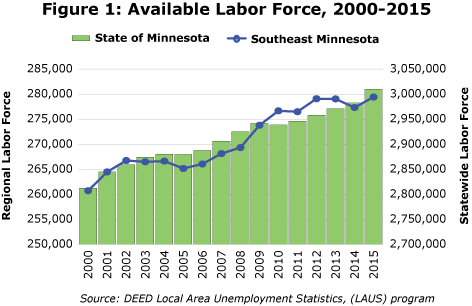
by Mark Schultz and Cameron Macht
June 2016
The Southeast labor force reached a record high last year, but many employers soon will be challenged to fill openings. Tapping a more diverse group of workers will be part of the solution.
After gaining over 2,000 new workers over the year, Southeast Minnesota's labor force reached a record 279,500 in 2015. Labor force growth in the region mirrored growth statewide over the last 15 years, with both expanding about 7 percent.
While the state added workers in all but two of those 15 years, Southeast had more volatility in response to changing economic conditions. The region gained over 6,000 workers during the 2001 recession, followed by a small decline through 2006. The area then added over 7,200 workers during the Great Recession. During the recovery, the labor force swelled again before leveling off at just over 279,000 workers in three of the last four years (see Figure 1).

The number of employed workers saw a surge of more than 3,300 people in the past year. Meanwhile, the number of unemployed workers in the region dropped by 1,220 people during that period. Falling below 9,500 unemployed people, the region now has the lowest number of active job seekers since 2001. At 3.4 percent in 2015, the region's unemployment rate is also the lowest reported since 2001 and the second lowest of the six regions in the state.
Southeast Minnesota's labor force participation rate also closely mirrors the state rate at 69.7 percent of the population ages 16 years and over in the labor force, compared with 70.1 percent statewide (see Table 1).
| Southeast Minnesota Employment Characteristics, 2014 | |||||
|---|---|---|---|---|---|
| - | - | Southeast Minnesota | Minnesota | ||
| - | In Labor Force | Labor Force Participation Rate | Unemployment Rate | Labor Force Participation Rate | Unemployment Rate |
| Total Labor Force | 274,538 | 69.7% | 5.7% | 70.1% | 6.5% |
| Employment Characteristics by Age Group | |||||
| 16 to 19 years | 15,985 | 56.4% | 19.1% | 51.1% | 18.7% |
| 20 to 24 years | 28,059 | 82.2% | 8.2% | 81.8% | 10.2% |
| 25 to 44 years | 105,677 | 87.7% | 5.4% | 88.1% | 5.8% |
| 45 to 54 years | 63,813 | 89.5% | 3.9% | 87.3% | 5.0% |
| 55 to 64 years | 47,697 | 75.5% | 3.2% | 71.8% | 4.9% |
| 65 to 74 years | 10,767 | 27.6% | 3.9% | 26.6% | 4.1% |
| 75 years and over | 2,566 | 6.9% | 2.5% | 5.9% | 3.5% |
| Employment Characteristics by Race and Hispanic Origin | |||||
| White alone | 255,856 | 69.9% | 5.3% | 70.2% | 5.6% |
| Black or African American | 5,519 | 59.9% | 17.8% | 68.0% | 16.4% |
| American Indian | 551 | 45.1% | 9.2% | 59.4% | 17.4% |
| Asian or Other Pac. Islanders | 7,117 | 71.8% | 4.0% | 70.6% | 7.2% |
| Some Other Race | 2,829 | 77.4% | 9.3% | 76.2% | 11.0% |
| Two or More Races | 2,704 | 69.2% | 11.5% | 69.5% | 13.2% |
| Hispanic or Latino | 11,586 | 72.1% | 11.6% | 75.0% | 10.1% |
| Employment Characteristics by Disability | |||||
| With Any Disability | 11,874 | 55.7% | 11.7% | 51.0% | 14.0% |
| Source: 2010-2014 American Community Survey, 5-Year Estimates | |||||
The details provide additional insight, with the region actually posting higher labor force participation rates than the state in all but one age group, the 25- to 44-year-old cohort. This age group, however, is the largest segment of the labor force at 38.5 percent, pulling the overall rate just below that of the state.
Combined with 45 to 54 year olds, these two age groups – considered the "prime working years" in regard to earnings and labor force participation rates – accounted for 62 percent of the workforce in the region. The region's concentration was about 3 percent lower than statewide, and shrank over the past decade as baby boomers aged.
While the middle-aged workforce experienced a decline, the state and Southeast region saw an increase in the number of workers 55 and over. Trailing only Southwest Minnesota, Southeast has the second-highest participation rate for older workers, standing well above the overall state rate.
Although labor force participation rates drop off sharply for workers as they reach the traditional retirement age of 65, they have increased over time. Even so, just under 28 percent of the region's residents ages 65 to 74 were in the labor force, while about 7 percent of those ages 75 and over were, closely matching the state rates for these groups.
The youngest workers were much more likely to be in the workforce in Southeast Minnesota than statewide, but they faced challenges finding work, with a staggering 19.1 percent unemployment rate.
People ages 20 to 24, many of whom are available for full-time permanent jobs, also had a higher unemployment rate than all older groups. These are the cohorts that are replacing retiring baby boomers and therefore represent a key resource for the region.
Though Southeast is less diverse than the state, the racial and ethnic characteristics of the region are changing rapidly. The two largest minority groups in the region – Hispanics and Asians – both had higher labor force participation rates than whites, and Asians also had lower unemployment rates.
In contrast, Hispanics and all other race groups had much higher unemployment rates than whites. People of "some other race" had the highest labor force participation rate in the region at 77.4 percent, which was 7.5 percent above whites. At the same time, the "some other race" category had an unemployment rate that was 4 percent higher than whites (see Table 1).
There were significant gaps in the participation and unemployment rates for blacks in the region. They had the highest unemployment rate at 17.8 percent and the second-lowest participation rate among all races, just below 60 percent. American Indians (the smallest race group in the region) had a participation rate of only 45 percent in the labor force.
Raising participation rates for blacks, American Indians and people of two or more races in line with whites would add 1,260 workers to the regional economy. Lowering unemployment rates for all other race groups except Asians in line with the white rate could help fill more than 1,600 jobs.
Steady gains in the number of entry-level and middle-aged workers and a huge jump in the number of older workers who decide to delay retirement should be enough to offset the losses projected in the 45- to 54-year-old age bracket from 2015 to 2025.
Applying current labor force participation rates to future population projections from the Minnesota State Demographic Center provides labor force projections for the region over the next decade. These show a modest 1 percent increase in the labor force, much smaller than the 5.5 percent growth seen in the last decade (see Table 2).
| Southeast Minnesota Labor Force Projections, 2015-2025 | ||||
|---|---|---|---|---|
| - | 2015 Labor Force | 2025 Labor Force Projection | 2015-2025 Change | |
| Numeric | Percent | |||
| 16 to 19 years | 17,296 | 17,179 | -37 | -0.2% |
| 20 to 24 years | 27,980 | 29,339 | +1,359 | +4.9% |
| 25 to 44 years | 106,195 | 110,303 | +4,108 | +3.9% |
| 45 to 54 years | 62,039 | 51,981 | -10,057 | -16.2% |
| 55 to 64 years | 51,212 | 51,412 | +199 | +0.4% |
| 65 to 74 years | 12,290 | 18,329 | +6,038 | +49.1% |
| 75 years and over | 2,882 | 3,961 | +1,079 | +37.4% |
| Total Labor Force | 279,815 | 282,503 | +2,689 | +1.0% |
|
Source: Minnesota State Demographic Center |
||||
This will likely lead to a tight labor market in the future as well, with Southeast employers needing to respond to changing labor force availability. The number of jobs in the region held by workers ages 55 and over jumped from 36,785 to 58,218 in the past 10 years, a 58 percent increase.
Across the Southeast, workers 55 and over now hold nearly one-quarter of the total jobs, up from 16.6 percent in 2005. The industries with the highest concentrations of these workers include transportation and warehousing (40 percent of all job holders) followed by real estate, rental and leasing, educational services, and finance and insurance, which were all above 30 percent (see Table 3).
| Southeast Minnesota Workforce by Industry, Second Quarter 2015 | |||
|---|---|---|---|
| - | Total Workers | Jobs Held by Workers
55 Years and Over |
|
| Number | Number | Percent | |
| Total, All Industries | 242,534 | 58,218 | 24.0% |
| Health Care and Social Assistance | 60,998 | 14,139 | 23.2% |
| Manufacturing | 40,277 | 10,306 | 25.6% |
| Educational Services | 22,018 | 6,728 | 30.6% |
| Retail Trade | 26,877 | 6,134 | 22.8% |
| Public Administration | 9,937 | 2,789 | 28.1% |
| Transportation and Warehousing | 6,704 | 2,674 | 40.0% |
| Accommodation and Food Services | 17,108 | 2,063 | 12.1% |
| Wholesale Trade | 7,792 | 1,992 | 25.6% |
| Admin. Support and Waste Mgmt. | 9,603 | 1,889 | 19.7% |
| Other Services | 6,844 | 1,664 | 24.3% |
| Construction | 8,710 | 1,569 | 18.0% |
| Finance and Insurance | 5,940 | 1,542 | 30.0% |
| Professional and Technical Services | 3,968 | 1,095 | 27.6% |
| Agriculture | 3,343 | 811 | 24.3% |
| Information | 3,603 | 717 | 20.0% |
| Arts, Entertainment and Recreation | 3,364 | 704 | 20.9% |
| Management of Companies | 3,114 | 640 | 20.6% |
| Real Estate, Rental and Leasing | 1,604 | 538 | 33.5% |
| Source: DEED Quarterly Workforce Indicators (QWI) program | |||
The health care and social assistance, manufacturing and educational services sectors will have the most replacement needs in the next decade. With more than 25 percent of all jobs, health care is easily the largest-employing industry in Southeast Minnesota and is projected to be the largest growing in the next decade as well.
Interestingly, even with their prevalence in the region, health care employers had a lower percentage of job holders over 55, suggesting that they are already actively recruiting and retaining younger workers. Other industries may follow their lead in the future.